It’s one thing for a country to have various regional cuisines. As we saw in the case of Croatia, the Dalmatian dishes like brodet are entirely different than what you might find in the mainland.
Georgia’s different regions, however, take this notion of regional independence to an entirely different level. For a dish like khachapuri, it seems that each region has its own say on the matter.
And while we’ll cover only one of them today, all of them seem exquisitely delicious.

Khachapuri, Acharuli and the Adjarians
More broadly, khachapuri is a true fan favorite throughout all of Georgia. As we’ll see later, the baseline of what makes khachapuri is leavened bread molded into a special shape and stuffed with copious – some might say decadent – amounts of cheese. Think 1:1 ratio, bread to cheese.
From this baseline, however, are different variations of khachapuri. There’s Imeruli, a circular form of khachapuri hailing from the Imereti region that might be the most common form. There’s also Megruli, a type of khachapuri from the Mingreli subethnic group that is somewhat similar to Imeruli but with much more cheese.
Finally, there’s acharuli, an entirely different shaped and prepared khachapuri from the Adjarians, which we find to be the most interesting variation of them all.
Cheese plus bread is such a delicious combo we absolutely love this recipe. Fried plus bread sounds yummy too, doesn’t it? If you love fried stuff, you’ve got to try our Sri Lankan fried bread. – it tastes more like a stir fry, but the base is a bread!
The Adjarians
While technically part of the greater Georgian nation, the Adjarians have had a slightly different and certainly unique historical trajectory from the rest of the nation.
Located just north of the Turkish border and with a direct border to the Black Sea, the land of Adjara has long been a valuable and coveted area in the region. One of the reasons for its immense value, in addition to its proximity to just about everything, is a highly favorable climate that can support diverse vegetation and tropical produce that very few places elsewhere around the Caucauses can sustain.
Adjara began as part of the kingdom of Colchis, an ancient union of Georgian tribes that offered a semblance of a unified state as early as the 13th century BC. By the 5th century BC, however, Adjara was swiftly colonized by the Greeks and then the Romans not long thereafter. As the Roman Empire began to fall, the land of Egrisi – the region of Roman-controlled lands of which Adjara was a part – evolved into a Byzantine stronghold and briefly part of the Sassanid Persian empire. It wasn’t until the 9th century AD when Adjara would be reunited with other Georgian lands into the first unified Kingdom of Georgia.
The Kingdom of Georgia rose to become a major regional power for several centuries, with the apex of its influence believed to be between the 12th and 13th centuries. The fall of other empires around it, most notably the Byzantine empire, and the rise of the Ottoman and new Persian empires led the predominantly Christian Georgians towards isolation and being surrounded by idealistically unfriendly neighbors.
The Adjarians in particular were greatly affected by the rise of these new regional powers. By the early 17th century, Adjara would eventually be conquered and annexed into the Ottoman Empire. As a result of this conquest, the Adjarian population, who were Christian like most of the Georgian Kingdom, were forced to convert to Islam.
Adjara would “change ownership” several more times over the following centuries. From the Ottomans, the land was then conquered by the growing Russian empire of the 19th century, followed by spells of Turkish and British rule during the World War I years, and finally becoming a fixture in the burgeoning Soviet Republic.
Under the Soviets, the Adjarians received an exceptional semi-autonomous nation status, although the region nevertheless had considerable ties to greater Georgia. By the fall of the Soviets, the Adjarians became part of the newly independent Georgian nation but still with a reasonable set of regional autonomy and self-governing liberties.
Impact on Adjarian Culture
Given their unique history and physical location relative to greater Georgia, the Adjarians have developed some cultural and culinary differences from the rest.
With such direct access to the Black Sea, for example, the Adjarians have a much greater appetite for fish and seafood in their local cuisine than the rest of Georgia. Coupled with a heavy preference for spice and exotic flavors stemming back from the Ottoman times, and many of these Adjarian fish dishes are very distinctive to the region. Also (and perhaps somewhat paradoxically), the Adjarians take great pride in their local dairy. When given the chance, they will find any way to flaunt their dairy preference.
Their version of khachapuri, as a result, has become a major point of pride for the region.
About the Recipe
As we mentioned a little earlier, all versions of khachapuri maintain varying version of a the same baseline: a mix of butter and cheese encased within a decadent bread.
Acharuli, the Adjarian version of khachapuri, does take a bit of a left turn from the rest. Instead of encasing the bread around the cheese, acharuli will leave the cheese open and exposed by creating instead a “bread boat.”
You start by creating the bread boat similar in the way you would create any other type of yeast-based bread. Because of ingredients like your milk and your butter, the dough will come out a little more decadent and rich than most normal breads, but the process for creating the dough is largely the same. You’ll want to first activate your yeast ahead of time before folding it into the dry ingredients and letting the dough rise.
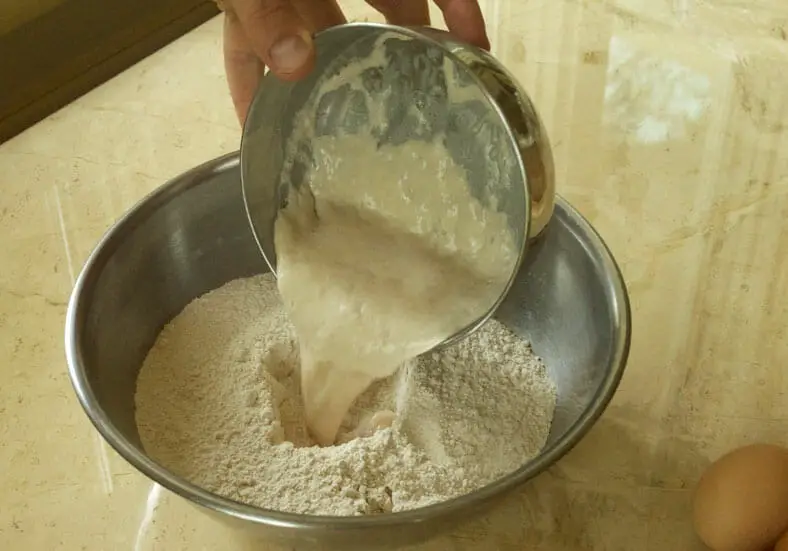
As the dough rises, you’ll create your cheesy filling of mixed grated cheeses. Most traditional acharuli recipes will call for special a Adjarian sourish cheese from the mountains, although more general khachapuri recipes are more forgiving when it comes to substituting more widely available cheeses. If making cheesy dishes if your thing and you love feta cheese or cream cheese as much as I do, definitely check out our favorite cheese stew with oyster mushrooms (ema datshi) recipe.
In addition to the grated cheeses, you’ll add at least an egg as a binder and, if you feel so inclined, some added herbs and aromatics.

When the dough has risen and is ready to go, you’ll start to shape it into its final form. Since we’re making the acharuli form of khachapuri, this means creating a boat shape where the side crusts are risen above the middle. As the khachapuri bakes, this will ensure that it retains a “boat” shape and that the cheese filling in the middle doesn’t melt out.



With your boat shape made, you’ll fill the acharuli with the cheese filling before popping it into the oven, but you’re not done just yet!
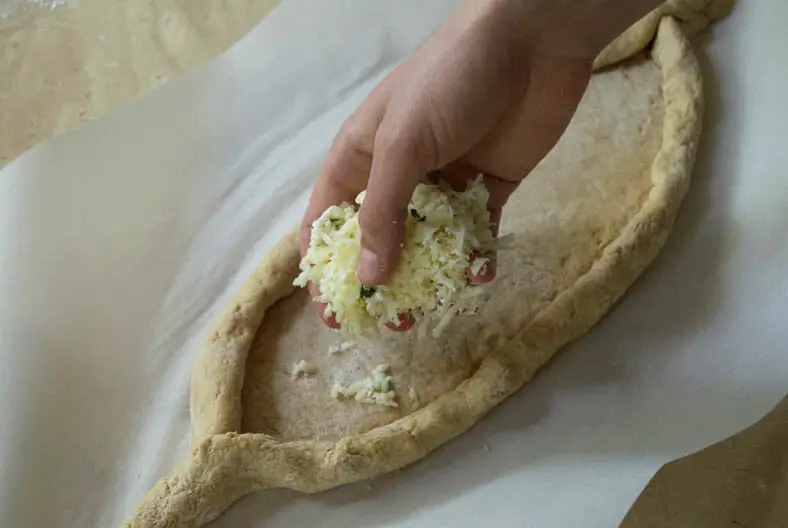

Another distinct feature of the acharuli version of khachapuri is the addition of a raw egg into the pool of boiling cheese midway through cooking. It’s a fantastic addition to the khachapuri and the runny yolk makes for a delicious dipping sauce for broken off pieces of bread.
To achieve this, simply pull your acharuli out of the oven midway through baking and, while the cheese is still very hot and pliable, carve out a small bed in which you can drop in your raw egg. Place your khachapuri back in the oven and continue to bake until it is fully cooked.
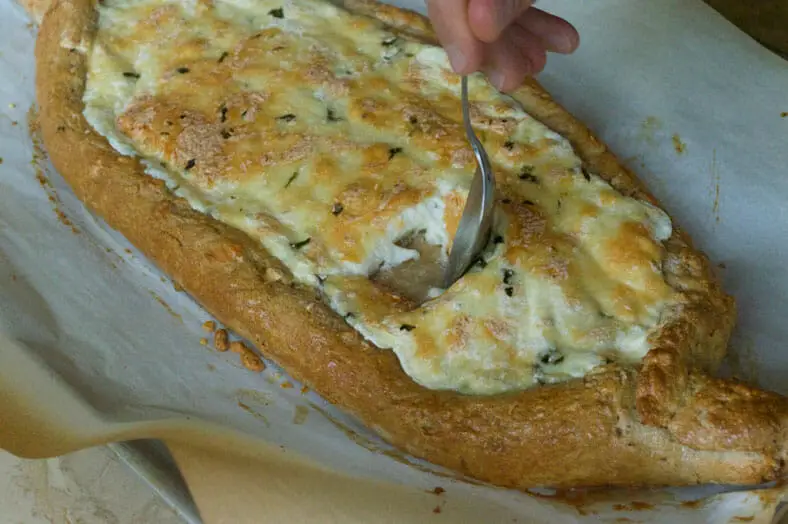
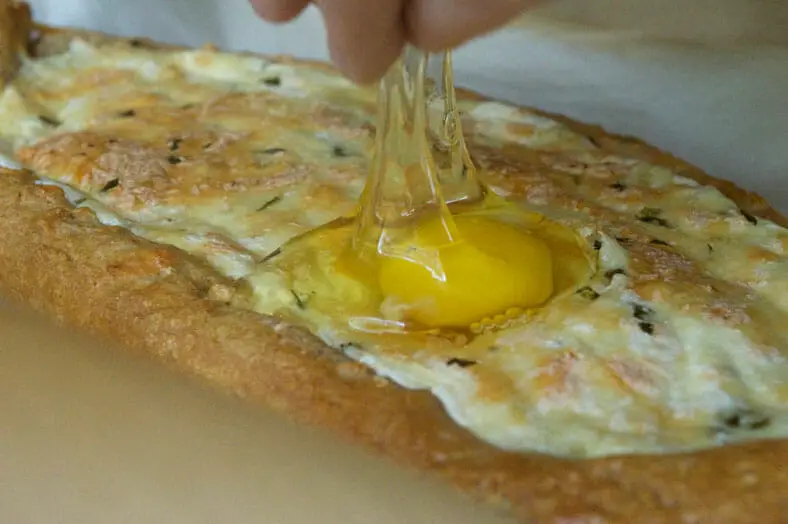
At this point, your khachapuri is ready to be eaten, but here’s where we’d highly recommend adding a nice spiced garnish. More to come on this particular part in the next section.
Our Take on the Recipe
There were a lot of great recipes to choose from when deciding which khachapuri recipe to make, but ultimately we were sold by the beautiful end result of our original reference recipe. Amid it’s beauty, however, the recipe itself was fairly hard to follow in its current structure, so one of our main objectives was to create a better documented recipe for others to follow.
In addition to better documentation, we did make a few changes. For the dough, we made an adjustment to include whole wheat pastry flour and added butter to make for a flakier crust. We also made our typical adjustment of using coconut sugar instead of regular sugar when we activating the yeast.
For the filling, we added tarragon as a fragrant herb and swapped in cheeses that are more readily available and simpler to procure for most people. These cheeses, havarti and mozzarella, are fantastic cheeses for melting and help retain much of the desired end-result of a traditional khachapuri.
Finally, we were intrigued by a particular spice mixture famous to Georgia by the name of khmeli suneli. As you’ll see in the recipe, khmeli suneli is a ground mixture of various aromatic herbs and some spices, and it provided a deliciously exotic kick to the khachapuri when sprinkled on at the end. Even if it isn’t directly linked to Adjara and the acharuli version, it is a fantastic add if you feel so inclined.

In all, khachapuri (and, more specifically, acharuli) is a fun, wholesome and delectable peek into the intricacies of both national and regional Georgian cuisines.
What version of khachapuri would you prefer to make? Comment below!
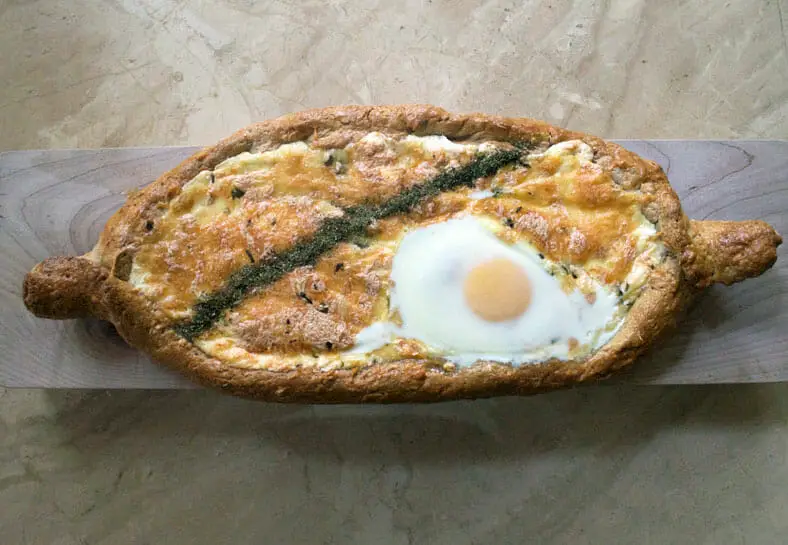

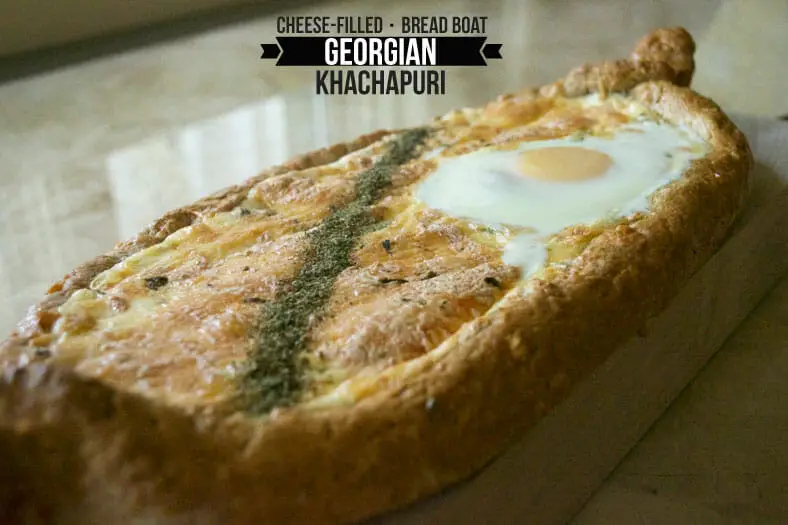
Great history lesson and a gorgeous Georgian Cheese Bread! I’m intrigued by the addition of the egg while cooking! Learned so much, what a beautiful blog you have!
Thank you Allie! We can totally recommend the mid-cooking adding of the egg… it really brings the entire khachapuri into a different stratosphere. If you happen to give it a try, let us know!
I love incorporating learning into cooking–I had my kids read this history lesson with me and now we will make the bread.
That’s so awesome, Kristen. Hopefully they enjoyed the history lesson as well 🙂
Keep us posted on how the bread turns out!
Wauw this looks interesting!
Keep it up the hard work 😀
Thank you Jesse!